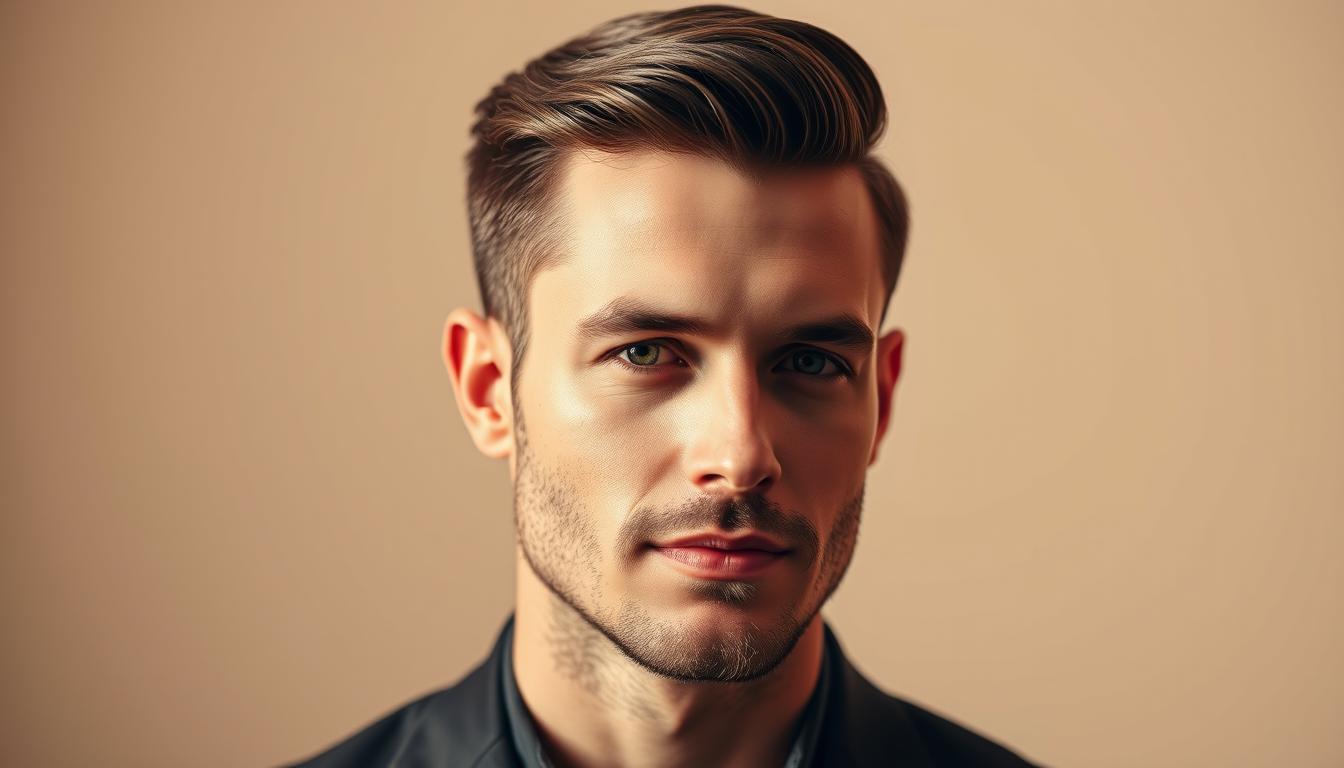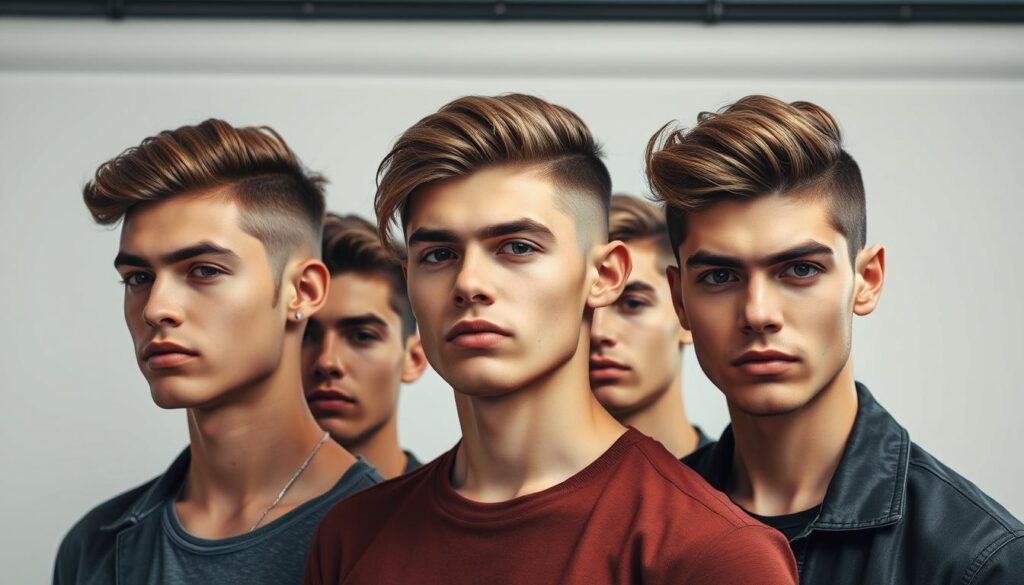
What hairstyle has survived every trend since the 1940s while staying effortlessly sharp? The answer lies in a look that’s been worn by presidents, Hollywood icons, and modern style leaders alike. This isn’t just about splitting strands to one side—it’s a symbol of timeless confidence that adapts to any era.
Originally popularized in the mid-20th century, this style became a staple for its clean lines and adaptability. Whether paired with a crisp suit or casual weekend wear, it maintains an air of sophistication. The secret? Its ability to work with nearly every hair type and face shape, offering endless variations without losing its core identity.
Today’s versions blend retro charm with modern edge. Think textured layers for a relaxed vibe or sleek comb-overs for boardroom-ready polish. It’s not just a haircut—it’s a foundation for personal expression, bridging generations of grooming excellence.
Key Takeaways
- Enduring style choice across decades
- Adapts to both classic and contemporary preferences
- Rooted in mid-century fashion history
- Customizable for individuality
- Associated with professionalism and confidence
Understanding the Classic Side Part Look

Imagine a look that’s defined elegance since the 1920s. This sharp grooming choice became a cultural force during Hollywood’s golden age, blending practicality with undeniable charm. Its staying power lies in balancing structure and adaptability—a formula perfected through generations.
The Rich History and Timeless Appeal
Born from strict gentlemanly standards, this style exploded in popularity when silver screen stars made it their signature. By the 1940s, it became shorthand for authority in corporate America. “A well-groomed man commands respect before speaking a word,” noted a 1952 barbering manual, capturing its cultural significance.
Key Elements That Define the Look
Three factors create its signature sharpness. First, precise length ratios: 3-4 inches up top allows versatile styling, while shorter sides maintain clean lines. Second, a distinct separation line—usually 1-2 inches from the temple—creates visual balance. Finally, quality products like matte clay ensure hold without stiffness.
Modern adaptations keep the core formula intact. Whether adding texture or pairing with fades, the foundation remains rooted in proportion and polish. It’s less about rigid rules and more about enhancing your natural features with timeless structure.
Explore Top Side Part Haircut Men Trends

Modern barbering turns classic foundations into fresh, personalized statements. Today’s trends balance sharp details with adaptable textures, letting you choose between office-ready polish and weekend-edge flair.
From Hard Parts to Modern Variations
The hard part trend reinvents simplicity with surgical precision. A razor-etched line transforms basic crops into groomed masterpieces, ideal for those craving structure without stiffness. Pair it with tapered fades for contrast that pops at corporate events or casual gatherings.
Longer lengths unlock creative freedom. Textured quiffs with natural volume work beautifully for wavy or straight hair, offering movement while keeping clean lines. Contemporary versions might blend disconnected undercuts with asymmetrical lengths—perfect for making bold statements.
Styling Essentials for Different Lengths
Short crops demand minimal effort: a dime-sized dab of matte paste adds definition. For medium styles, lightweight clays provide lift without crunch. Pro tip: Blow-dry damp hair upward before applying product to maximize height.
Fades and textured finishes require regular trims—every 3-4 weeks—to maintain sharpness. Invest in a quality trimmer for touch-ups between salon visits. Remember: the best looks marry precision with your hair’s natural behavior.
Styling Tips for a Dapper, Polished Appearance
Your grooming arsenal determines whether your style stays sharp or fades by noon. The right combination of products and techniques keeps every strand in place while preserving natural movement.
Choosing the Right Pomade, Gel, or Clay
Water-based pomades like Suavecito Original Hold deliver flexible control with a vintage sheen—ideal for medium-length styles. For thicker textures, matte clays add definition without shine. “Start with a pea-sized amount,” advises barber Marco Rivera. “You can always add more, but too much weighs hair down.”
Fine hair thrives with lightweight creams, while gels tame unruly waves. Avoid oil-based products if you prefer easy washing. Test different finishes: high-shine for formal events, natural texture for casual days.
Maintaining Your Look Throughout the Day
Blot excess oil with a microfiber cloth instead of reapplying product. Carry a travel-sized clay for midday touch-ups—rub between palms and smooth flyaways. Humidity? Lock strands with a light hairspray mist.
Adjust your routine based on activity. Office days demand stronger hold products, while weekends benefit from flexible pastes. Remember: great style adapts without losing its core polish.
Side Part Hairstyles to Suit Every Hair Type
Your hair’s unique texture shouldn’t limit your style options—it should define them. This timeless look thrives on adaptability, offering tailored solutions whether your strands are fine as silk or dense as a forest canopy. The key lies in enhancing what you naturally have rather than forcing unnatural shapes.
Easy Adjustments for Straight, Wavy, and Curly Hair
Fine or thin textures gain instant dimension when styled with a side separation. Embrace its natural fall—a light mousse adds gentle lift without overwhelming delicate strands. For wavy textures, let the waves cascade from the part line. A sea salt spray enhances movement while keeping definition.
Thick or coarse types? Leverage that density. Blow-dry upward before sweeping strands sideways for voluminous quiffs that hold all day. Asian hair’s strength allows sculpted styles with minimal product. “Work with your hair’s weight,” suggests LA stylist Jin Lee. “Thicker textures need direction, not force.”
Curly and frizzy types shine when texture becomes intentional. Define curls with a curl cream before creating the part, allowing natural volume to frame the face. A matte paste tames flyaways while maintaining that effortless ‘lived-in’ charm.
Every choice—from product consistency to cutting techniques—should align with your hair’s behavior. Whether you’re enhancing waves or managing thickness, success comes from celebrating your texture’s inherent strengths.
Integrating the Side Part with Contemporary Trends
Classic meets cutting-edge when traditional grooming gets a modern refresh. Today’s stylists fuse vintage foundations with bold techniques, creating looks that feel both familiar and fresh. The secret? Strategic updates that honor the original style’s DNA while pushing boundaries.
Modern Fades, Undercuts, and Quiff Combos
Skin fades elevate basic styles into head-turners. Ask for a #000 blade near the ears, blending upward into longer lengths. This sharp contrast makes the separation line pop while keeping workplace appropriateness. Pair it with a textured top for weekend-ready edge.
Undercuts create drama through contrast. Keep the sides cropped close while letting the top flow sideways. “The disconnect between lengths draws eyes to your best features,” explains NYC barber Elena Torres. Add a razor-sharp part line for extra definition that lasts all day.
Quiff hybrids bring movement to structured styles. Blow-dry the front section upward before sweeping it sideways. Use a matte clay to lock in volume without stiffness. This works wonders for guys with straight or wavy textures craving dimension.
- Mid-fades maintain professionalism while showcasing modern techniques
- Temple fades emphasize angular jawlines when paired with side parts
- Disconnected undercuts allow creative styling freedom up top
Balance remains crucial. Keep the top length between 2-4 inches for versatile styling. Schedule trims every 3 weeks to maintain crisp lines. With these updates, your look stays rooted in tradition while embracing today’s best trends.
Pro Tips from Barbers and Style Experts
Mastering this timeless style requires more than just good scissors – it demands insider knowledge. Top grooming professionals reveal their secrets for achieving precision and avoiding rookie errors.
Expert Product Recommendations and Tricks
Scissor cuts create cleaner lines than clippers for vintage-inspired looks. “Blended shears create natural graduation,” explains Chicago barber Luis Mendez. Pair this technique with water-based creams for flexible hold that doesn’t flatten your style.
| Hair Type | Product | Application Tip |
|---|---|---|
| Fine/Thin | Lightweight Mousse | Apply to damp roots before blow-drying |
| Thick/Coarse | Matte Clay | Warm between palms first |
| Curly | Curl Defining Cream | Comb through before creating part |
Avoiding Common Pitfalls and Mistakes
70% of men choose the wrong parting side. “Follow your natural growth pattern,” advises NYC stylist Rachel Cho. Oval faces suit centered parts, while square jaws need off-center lines for balance.
Military cuts gain sophistication when paired with razor-sharp separation. Use a tail comb to etch clean lines, then set with medium-hold spray. Remember: Over-styling kills volume – less product often works better.
Conclusion
A well-crafted style speaks volumes without uttering a word. This iconic separation has evolved from boardrooms to brunch spots, proving its adaptability across generations. Its strength lies in balancing clean structure with personal flair—whether you prefer tapered fades or textured tops.
Through decades of trends, this look maintains relevance by celebrating individuality. Proper product choices and cutting techniques let you tailor it to your hair’s natural behavior. Office-ready polish or weekend texture? Both work when fundamentals align with your lifestyle.
Remember: great grooming isn’t about rigid rules. It’s about enhancing your best features through intentional design. With the right approach, you’ll command attention in any setting—sharp enough for meetings, relaxed enough for rooftop cocktails.
Your final move? Walk out with the quiet confidence that comes from mastering a timeless art form.
